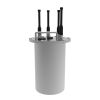NexSens WQData LIVE Web Datacenter
Features
- 2-way communication with remote systems
- Interactive ESRI Leaflet map interface
- View & download tabular and graphical data
- Expedited repair and warranty service
- Lifetime technical support
- More
WQData LIVE is a web-based project management service that allows users 24/7 instant access to data collected from remote telemetry systems. Users with NexSens X-Series data logger platforms have the ability to configure and update systems remotely via Wi-Fi, cellular or satellite telemetry. All projects are password-protected with multi-level access. Administrators have full access for remote communication and project modification, while collaborators are limited to viewing and exporting data.
The online database offers the ability to view live readings, configure alerts to notify project personnel when data values exceed threshold limits, export data and more. The project dashboard includes a ESRI Leaflet map view showing all project sites on a map with zoom, scroll and drag capability. The bottom of the dashboard includes a project overview, data disclaimer and project photo. For projects with multiple locations, each site within a project shows the data loggers connected along with a site photo in a convenient viewing pane.
Clicking on any site within a project displays the most recent data values alongside a graph depicting a day, week, month or year of data. Within each parameter, users can register to receive alerts via email based on a high or low threshold. A rich set of meta data and diagnostic data specific to each site is displayed at the bottom for troubleshooting sensor or data logger issues. With this rich set of tools, WQData LIVE simplifies the task of managing an environmental monitoring project.
In The News
Wave-Powered Buoy Deployed in Puget Sound
While the development of solar-powered monitoring systems has improved access to real-time environmental data, solar power is still limited by low light conditions, such as poor weather, nighttime, or high-latitude environments. To supplement these incumbent power solutions at sea, Ocean Motion Technologies has developed a small-scale ocean wave energy system that can be directly integrated with existing data buoy platforms. Not only does wave energy supplement solar power during periods when the buoys are limited by light availability, but it also allows data buoys to perform beyond their current power capacities.
Read MoreNo Red Herrings: Data Driving the Largest Salt Marsh Restoration in the NE USA
The Herring River system encompasses around 1,000 acres in the Towns of Wellfleet and Truro, Massachusetts. In 1909, the Chequessett Neck Road dike was built at the river’s mouth, drastically limiting tidal flow. Today, it’s one of the most restricted estuaries in the northeastern United States. As a result, the area has suffered environmental decline, including poor water quality, hypoxia, lower pH, and salt marsh degradation. In 2023, the Town of Wellfleet received $14.7 million from NOAA’s Office of Habitat Conservation to fund the Herring River Restoration Project (HRRP). Francesco Peri, President and CEO at Charybdis Group LLC, uses a network of NexSens data loggers to monitor water level and water quality on the Herring River.
Read MoreExpanding the Port Everglades: Real-Time Monitoring of Water Quality Conditions from Planned Dredging Operation
The Port Everglades in Broward County, Florida, serves large trade vessels and cruiseliners and incoming and outgoing recreational boaters. However, as cargo ships become larger, the port must expand. A dredging project led by the US Army Corps of Engineers will substantially deepen and widen the port's navigation channel to accommodate larger Panamax cargo ships and modern cruise liners. As a result of this project, a large amount of sediment will be displaced into the water column. This suspended sediment may settle outside of the project area, burying benthic organisms like corals, and possibly carrying harmful particulates to other regions. [caption id="attachment_39497" align="aligncenter" width="2560"] A CB-950 and CB-25 deployed on site at Port Everglades.
Read More













